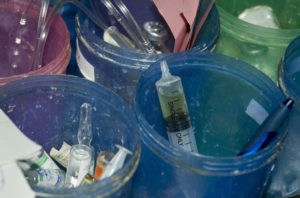
Start your engines: A fleet of GoBabyGo cars, customized by therapists and parents to give disabled children mobility and help strengthen weak muscles. (Courtesy Cole Galloway)
$100 plastic car stands in for $25,000 power wheelchair
In the first (and likely only) National Institutes of Health-funded shopping spree at Toys R’ Us, Cole Galloway, director of the Pediatric Mobility Lab at the University of Delaware, and crew stocked up on pint-sized riding toys.
Galloway’s quest was to facilitate independence and mobility among disabled children from the age of six months and older and offer a low-tech solution during the five-year wait in the United States for a $25,000 power pediatric wheelchair.
The hackers jerry-rigged the toys with pool noodles, PVC pipe and switches, reconfiguring them as mobile rehabilitation devices to promote functional skills among kids with special needs. With the flip of a switch, parents or therapists can nudge riders to shift weight, stand and push forward—fostering independence and building leg muscles.
The secret of his success? “You need the logical brain of a scientist, the creativity of an artist and the patience of a toddler.”
Shakira inspires concussion diagnostic
With a little help from Shakira and her infamous hips, Uzma Samadani, MD, PhD, aims to shed new light on brain injuries after concussion.
“Every eight seconds, someone in the United States gets a blow to the head, and we can’t tell how badly they are hurt, and, in some cases, whether or not they are hurt at all,” says Samadani, chief of neurosurgery at New York Harbor Health Care System.
She used a Shakira music video as visual stimulation for an eye-tracking system that assesses brain function by following the eye movements of patients with severe brain injuries. When comparing them with healthy adult volunteers, Samadani realized they moved their eyes in different ways.
Further research showed that the system could detect, measure and quantitate brain injury, and it may be able to locate the injuries. Samadani founded Occulogica to develop the technology.
The 30-year quest for a safe syringe

By one estimate, 17 billion injections are given each year in the developing world, and 7 billion are unsafe. (Courtesy Safepoint)
Re-use of syringes is responsible for more than 1.3 million deaths annually, according to the World Health Organization (WHO). It took Koska 13 years to invent an auto-disable syringe that cannot be reused; bringing it to market required nearly two decades more.
Koska has worked with WHO and The Safepoint Trust to launch a comprehensive strategy that covers technology, policy, funding and supply-chain issues to disseminate the auto-disable syringe. At TEDMED, WHO announced its global health initiative and policy focused on needle safety.
Join us at the Global Pediatric Innovation Summit + Awards 2014 on October 30-31 at Boston’s Seaport World Trade Center. Seats are limited, so register today at www.takingontomorrow.org. Please use the code VECTOR at check-out for a 10% discount.







